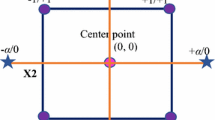Abstract
In the machining of stone–plastic composites, the cutting efficiency and increased economy are important considerations. To this end, stone–plastic composite was up-milled using tapered cutters. Cutting forces and temperature were measured under varied angle geometries and cutting parameters. Response surface methodology allowed the analysis of changes in cutting forces and temperature, and the significant contributions of each variable and their two-level interactions were determined. Correlations between actual and predicted results were found by developing mathematical models for cutting forces and temperature, which can be used to make accurate predictions. Finally, the optimisation of cutting conditions for tapered milling stone–plastic composites by minimising cutting forces and temperature was determined as taper angle 75°, feed per tooth 0.44 mm and cutting depth 0.5 mm. It is proposed that these parameters be adopted in industrial machining for higher machining efficiency and lower production cost.







Similar content being viewed by others
References
X.L. Guo, Z.L. Zhu, M. Ekevad, B. Xu, and P.X. Cao, Adv. Appl. Ceram. 117, 16 (2017). https://doi.org/10.1080/17436753.2017.1368946.
I.S. Kang, J.S. Kim, J.H. Kim, M.C. Kang, and Y.W. Seo, Mater. Process. Technol. 187, 250 (2007). https://doi.org/10.1016/j.jmatprotec.2006.11.155.
S. An, Y.N. Cheng, X.L. Liu, M.Y. Li, and L. Shi, Key Eng. Mater. 589–590, 421 (2013). https://doi.org/10.4028/www.scientific.net/KEM.589-590.421.
J.H. Li, J. Sun, and Y.Q. Chang, Doors Windows 10, 10 (2010). https://doi.org/10.3969/j.issn.1673-8780.2010.10.002.
Y.Z. Li, C.N. Patent 1 013 069 27A. Feb. 24, 2008. https://patents.google.com/patent/CN101306927A/zh
S. Turchetta, Int. J. Adv. Manuf. Technol. 61, 441 (2012). https://doi.org/10.1007/s00170-011-3717-4.
M. Zhou, B.K.A. Ngoi, M.N. Yusoff, and X.J. Wang, J. Mater. Process. Technol. 174, 29 (2006). https://doi.org/10.1016/j.jmatprotec.2005.02.248.
W.G. Li, Z.K. Zhang, X.R. Peng, and B. Li, Ann. For. Sci. 74, 37 (2017). https://doi.org/10.1007/s13595-017-0632-3.
P.X. Cao, Z.L. Zhu, D. Buck, X.L. Guo, M. Ekevad, and X.D. Wang, J. Mech. Sci. Technol. 3, 351 (2019). https://doi.org/10.1007/s12206-018-1237-y.
Z.L. Zhu, D. Buck, X.L. Guo, P.X. Cao, and M. Ekevad, Appl. Sci. (Basel) 9, 1373 (2019). https://doi.org/10.3390/app9071373.
Z.L. Zhu, D. Buck, X.L. Guo, M. Ekevad, and P.X. Cao, Sci. Adv. Mater. 11, 884 (2019). https://doi.org/10.1166/sam.2019.3538.
M. Belmonte, F.J. Oliveira, J. Sacramento, A.J.S. Fernandes, and R.F. Silva, Diam. Relat. Mater. 13, 843 (2004). https://doi.org/10.1016/j.diamond.2003.11.018.
M.V. Ramesh, W.B. Lee, C.F. Cheung, and K.C. Chan, Mater. Manuf. Process. 16, 61 (2001). https://doi.org/10.1081/AMP-100103697.
S.H. Yeo, M. Zhou, K.A. Ngoi, and S.P. Yap, Mater. Manuf. Process. 14, 875 (1999). https://doi.org/10.1080/10426919908914879.
H. Huang, N. Guo, and X.P. Xu, Key Eng. Mater. 404, 185 (2009). https://doi.org/10.4028/www.scientific.net/KEM.404.185.
H. Aouici, M.A. Yallese, K. Chaoui, T. Mabrouki, and J.F. Rigal, Measurement 45, 344 (2012). https://doi.org/10.1016/j.measurement.2011.11.011.
R.K. Bhushan, J. Clean. Prod. 39, 242 (2013). https://doi.org/10.1016/j.jclepro.2012.08.008.
A.K. Sahoo and P.C. Mishra, Int. J. Ind. Eng. Comput. 5, 407–416 (2014). https://doi.org/10.5267/j.ijiec.2014.4.002.
M. Mia and N.R. Dhar, J. Adv. Res. 7, 1035 (2016). https://doi.org/10.1016/j.jare.2016.05.004.
P.X. Cao, Z.L. Zhu, X.L. Guo, X.D. Wang, C.C. Fu, and C. Zhang, Appl. Sci. (Basel) 9, 2533 (2019). https://doi.org/10.3390/app9122533.
R.R. Li, X. Wei, X.D. Wang, and C.G. Wang, J. Clean. Prod. 183, 818 (2018). https://doi.org/10.1016/j.jclepro.2018.02.194.
R.R. Li, L. Fang, W. Xu, X.Q. Xiong, and X.D. Alice, Sci. Adv. Mater. 11, 655 (2019). https://doi.org/10.1166/sam.2019.3450.
Z.L. Zhu, P.X. Cao, X.L. Guo, X.D. Wang, F. Zhang, and Y. Gao, Materials 12, 2174 (2019). https://doi.org/10.3390/ma12132174.
H. Puls, F. Klocke, and D. Veselovac, Int. J. Adv. Manuf. Technol. 86, 737 (2016). https://doi.org/10.1007/s00170-015-8190-z.
S.T. Newman, A. Nassehi, R. Imani-Asrai, and V. Dhokia, CIRP J. Manuf. Sci. Technol. 5, 127 (2012). https://doi.org/10.1016/j.cirpj.2012.03.007.
X.Q. Xiong, Q.R. Ma, Y.Y. Yuan, Z.H. Wu, and M. Zhang, J. Clean Prod. 267, 121957 (2020). https://doi.org/10.1016/j.jclepro.2020.121957.
D.H. Zhu, X.M. Zhang, and H. Ding, Int. J. Mach. Tool. Manuf. 64, 60 (2013). https://doi.org/10.1016/j.ijmachtools.2012.08.001.
Funding
This work was supported by the National Natural Science Foundation of China (Grant No. 31971594), the Project from the International Cooperation Joint Laboratory for Production, Education, Research and Application of Ecological Health Care on Home Furnishing, and the National Key R&D Program of China (2018YFD0600304).
Author information
Authors and Affiliations
Corresponding author
Ethics declarations
Conflict of interest
The authors declare that they have no conflict of interest.
Additional information
Publisher's Note
Springer Nature remains neutral with regard to jurisdictional claims in published maps and institutional affiliations.
Electronic supplementary material
Below is the link to the electronic supplementary material.
Rights and permissions
About this article
Cite this article
Zhu, Z., Buck, D., Cao, P. et al. Assessment of Cutting Forces and Temperature in Tapered Milling of Stone–Plastic Composite Using Response Surface Methodology. JOM 72, 3917–3925 (2020). https://doi.org/10.1007/s11837-020-04368-1
Received:
Accepted:
Published:
Issue Date:
DOI: https://doi.org/10.1007/s11837-020-04368-1




